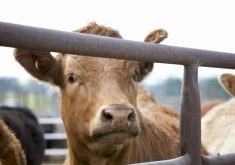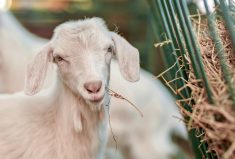Courtney Pranger battled with kid mortality issues in the early part of launching a dairy goat farm with her husband Josh.
“We lost 90 per cent of our kids the first year (due to Q fever), which was very traumatic,” she said, adding she was constantly in tears over it.
Why it matters: Reducing kid deaths boosts productivity and profits, and also eases emotional strain on producers.
Read Also

BinSentry sensors reduce feed-bin outages
BinSentry sensors mean fewer feed bin outages and more efficient deliver for feed mills.
When the opportunity to join a three-year kid mortality study presented itself, she hesitated, not wanting to be judged on her high death rates, or have people think she was a horrible person.
“I have to do this because I need to know what’s wrong with my farm, and it will help other people who are struggling as well,” she said. “I’m sure I’m not the only person out there (with high death rates).”
The risk paid off and now Mapleton Meadows, in its fifth year, with a thriving 250-head dairy herd operation, has a five per cent kid mortality rate.
On average, kid mortality sits between 20 to 30 per cent in the dairy goat industry but single-digit percentages are attainable through minor management adjustments revealed through the study and could increase the stability and profit of the sector.
“A lot of us don’t want to talk about deaths, but honestly it’s a really important part of … (answering) how do we prevent mortalities in the long run?” said Cathy Bauman, assistant professor, University of Guelph, Ontario Veterinary College speaking at the virtual Grey Bruce Farmers’ Week goat day.
Bauman led the three-year study, which encompassed a wide spectrum of farm participants. They were required to keep in-depth records for each kid born noting its sex, litter size, birth weight and the age of death to highlight challenge areas.
Pranger went a step further creating an in-depth sheet for each kid including its ID, the ID for the dam and sire (if known), how the kidding went if it needed assistance, how many kids, if any were stillborn, checks for selenium, vitamins A and D, weaning weight and adult ID number.
After her experience with high mortality rates in the first 48 hours due to Q fever and early births, Pranger spoke to nutritionists and created a program adding half a cc of Bovi-glo or Nutra-Glo before colostrum.
She tracked her does’ breeding schedules, installed cameras to alert her to kiddings and took temperatures to ensure the kids were warm and dry to increase the 48-hour survival rate.
The study showed the causes of kid mortality within the first 48 hours are premature or small kids, septicemia, pneumonia, starvation and diarrhea. The last four carry forward for mortality in all age groups, said Bauman.
“(In the) pre-weaning period how are we managing how we milk feed? And then weaning to shipping, there’s different things that are going on in that (time frame).”
Bauman said the research highlighted some issues off the radar.
“I had no idea how big a role starvation was playing in us losing kids,” said Bauman. “That was a major finding for my end.”
The Prangers reinsulated their nursery wall to keep temperatures consistent and initiated iodine dipping feet and navels after an article suggested both were at risk for bacteria absorption within the first 48 hours.
That simple change in management protocol dropped the number of kids euthanized due to joint ill from 12 to zero.
Sharing knowledge with their small ruminant vet has been useful.
“She’s been able to walk in and really give us some good advice, but to give her extra knowledge of the specifics for our farm definitely helped,” said Pranger.
“We can treat them accordingly and get on top of them faster and save their lives,” Pranger said. “Because goats have such a small time period for that treatment, if you don’t catch them soon enough you can pump them full of meds and it won’t do anything.”
Next to the first 48 hours, kids are at highest risk during the seven days to weaning time frame, said Bauman, where pneumonia is the top culprit with diarrhea is a close runner-up.
Bauman said Cryptosporidium occurs as early as seven to 10 days, however, Coccidia does not occur before three weeks.
“It’s very hard to raise these animals and transition them to weaning without having a coccidiostat in the feed,” said Bauman.
She said the study revealed higher kid mortality rates for producers in their first-to-third year in the industry were likely due to the steep learning curve.
While a small portion of producers had a one per cent mortality rate, overall, in each of the four age categories, the study showed most were in the 20 to 30 per cent range and some struggled with 50 per cent or higher.
Bauman hopes the research and farm-specific investigation will help producers make management adjustments that lower their losses to less than eight to 10 per cent collectively across all the age groups.
Risks to watch with young goat kids
A University of Guelph study showed the main causes of mortality zero to 48 hours after birth.
1. premature or small
2. Septicemia
3. Pneumonia
4. Starvation
5. Diarrhea
Timeline of Opportunity:
Use of pre-breeding abortion vaccines if needed, ultra-sound and BCS does 60 to 80 days pregnancy, vaccinating does for clostridial disease.
Causes of mortality for 48 hours to seven days:
1. Pneumonia
2. Diarrhea
3. Septicemia
4. Starvation
Timeline of Opportunity:
Tighten up management of the first 48 hours, intervene with extra bottles and electrolytes, provide extra attention and care to rough starters
Causes of mortality for seven days to weaning, the greatest risk period:
1. Pneumonia
2. Diarrhea
3. Septicemia
4. Starvation
Timeline of Opportunity:
Clean bedding to mitigate ammonia, humidity between 60 and 80 per cent, and adequate ventilation, keep an eye on overstocking due to rapid increase in growth.















